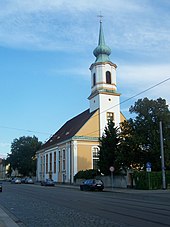Matthäuskirche (Dresden)
The Matthäuskirche is an Evangelical Lutheran parish church in the Friedrichstadt district of Dresden . The baroque church, built in the 18th century, was badly damaged in 1945 and rebuilt in the post-war period . It is registered as an architectural monument in the list of monuments of the city of Dresden.
history
The church was built in the course of the increasing settlement of Friedrichstadt for the Protestant community of the suburb, which was newly formed in 1725. On May 28, 1728 the foundation stone was laid for the house of God on the property of the Inner Matthew Cemetery . The plans for the new church come from the master builder Matthäus Daniel Pöppelmann . Johann Georg Gebhardt and George Bähr were probably also involved in the construction. The carpentry work was done by Abraham Krümmer, the stone carving work by Johann Heinrich Petersill. On June 11, 1730, the church was consecrated by the Dresden superintendent Valentin Ernst Löscher .
In 1768, the altar of the Annenkirche, originally from the old Dresden Frauenkirche , was moved to the Friedrichstadt church. As early as 1737 the church received an organ from the castle chapel . The grave of the master builder Matthäus Daniel Pöppelmann, who died in 1736, is located in the family crypt under the church.
In 1882, in connection with renovation work, the interior of the church was redesigned by Christian Friedrich Arnold , whereby the originally Baroque interior was lost. A year later the church was officially given its current name, Matthäuskirche. In 1884 the painter Erhard Ludewig Winterstein created the drafts for the approx. 8 m² large church window above the main portal on the north side, the middle part of which depicted the Evangelist Matthew , surrounded by 16 medallions of personalities from the history of the Church. During a renewed renovation in 1928, Walter Raum returned some of it to its original state .
The Matthäuskirche was badly damaged in the air raids on Dresden in 1945 and burned out. The entire equipment, including the organ and the valuable altar, was lost. Despite efforts by the parish, only a few security work could be carried out in the post-war period. In 1956 the Pöppelmann crypt was first renovated, and further work on the church ruins in the mid-1960s. The planned reconstruction began in 1974 under the direction of the architect Christian Möller. It was decided to faithfully restore the exterior including the original color scheme of the Baroque period , while the interior was redesigned in a modern way.
The only pieces of equipment today are a simple metal altar table, a metal cross decorated with red glass and a copper stele. The works of art come from Werner Juza's workshop .
Since 1999, the Matthäuskirche has belonged to the Annenkirche as a subsidiary parish .
Peal
The ringing consists of three bronze bells , the bell cage and the bell yokes are made of steel. Below is a data overview of the bell:
| No. | Casting date | Caster | diameter | Dimensions | material | Chime |
|---|---|---|---|---|---|---|
| 1 | 1976 | Schilling bell foundry | bronze | 1080 mm | 800 kg | f sharp ′ |
| 2 | 1976 | Schilling bell foundry | bronze | 890 mm | 450 kg | a ′ |
| 3 | 1976 | Schilling bell foundry | bronze | 790 mm | 300 kg | H' |
literature
- Jürgen Helfricht : Dresden and its churches . Evangelische Verlagsanstalt Leipzig, 2005, ISBN 978-3374022618 .
- Volker Helas : Monuments in Saxony - City of Dresden - Friedrichstadt . Monument topography Federal Republic of Germany, Verlag der Kunst Dresden / Basel, 1994, ISBN 978-3364002804 .
- Rainer Thümmel : Bells in Saxony . Sound between heaven and earth. Ed .: Evangelical Regional Church Office of Saxony . 2nd, updated and supplemented edition. Evangelische Verlagsanstalt, Leipzig 2015, ISBN 978-3-374-02871-9 , p. 289 (With a foreword by Jochen Bohl and photographs by Klaus-Peter Meißner}).
Individual evidence
- ^ Radeberger Zeitung , Supplement No. 45 of April 12, 1884.
- ^ A b Rainer Thümmel : Bells in Saxony . Sound between heaven and earth. Ed .: Evangelical Regional Church Office of Saxony . 2nd, updated and supplemented edition. Evangelische Verlagsanstalt, Leipzig 2015, ISBN 978-3-374-02871-9 , pp. 289 (With a foreword by Jochen Bohl and photographs by Klaus-Peter Meißner).
Web links
Coordinates: 51 ° 3 '37.3 " N , 13 ° 42' 57.5" E


